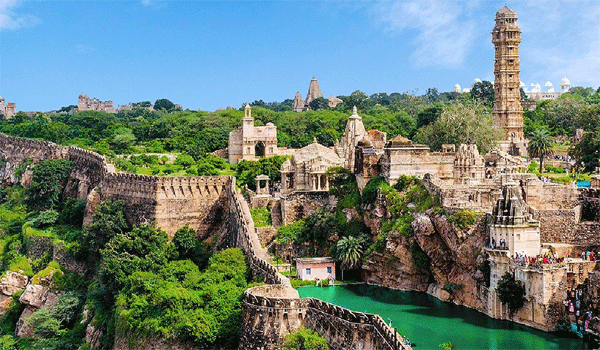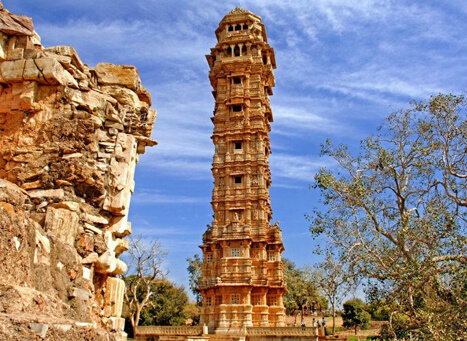Places To Visit In Chittorgarh || Chittorgarh Fort Attraction
Chittorgarh is one of the most enchanting cities of Rajasthan. Synonymous with bravery and romance, this city reflects the glorious history of Rajputs. It was once the seat of power in India. This land boasts of several interesting legends and tales of Rajputs.
Some of the main attractions of Chittorgarh are:
Chittorgarh Fort Chittorgarh :-
The most fabulous attraction of the city, this fort is the largest fort in India. Considered as one of the best forts of Rajasthan, it was built in the 7th century in a majestic Rajput architectural style. Beautifully set on a 180 m high hill, the fort boasts of several attractions such as Fateh Prakash Palace, Rana Kumbha Palace, Rani Padmini’s Palace and Chhhatris. A visit to this fort will take you back to the times of Rajputs.

The most fabulous attraction of the city, this fort is the largest fort in India. Considered as one of the best forts of Rajasthan, it was built in the 7th century in a majestic Rajput architectural style. Beautifully set on a 180 m high hill, the fort boasts of several attractions such as Fateh Prakash Palace, Rana Kumbha Palace, Rani Padmini’s Palace and Chhhatris. A visit to this fort will take you back to the times of Rajputs.

Rana Kumbha Palace Chittorgarh :-
Rana Kumbha Palace is a part of number of legends. These legends are associated with queen Padmini of Chittorgarh. The palace is also named after the greatest of the Sisodias. The location of the palace also has its association with the history of the place. It is in this location where Padmini committed Jauhar or self immolation. The self immolation was also joined by 700 followers to save honor. This was done as a way to avoid getting dishonored at the hands of the enemies. However, after much effort, archaeologists still haven’t discovered the underground cellars where this act was performed.

Rana Kumbha Palace is a part of number of legends. These legends are associated with queen Padmini of Chittorgarh. The palace is also named after the greatest of the Sisodias. The location of the palace also has its association with the history of the place. It is in this location where Padmini committed Jauhar or self immolation. The self immolation was also joined by 700 followers to save honor. This was done as a way to avoid getting dishonored at the hands of the enemies. However, after much effort, archaeologists still haven’t discovered the underground cellars where this act was performed.

On visiting the Rana Kumbha Palace, you will surely be able to come across a number of historically significant items. The palace was built by Bappa Rawal in 734 AD. He was the founder of the House of Mewar. It was later renovated by Maharana Kumbha. The palace had also played the role of residence to Princess Mira Bai. She was a famous poetess of that era. The palace also has its association with the legend of Panna Dhai who saved infant Udai Singh.
Vijay Stambh Chittorgarh :-
Vijay Stambh or the Tower of Victory is yet another historical monument that shows the valour and vigour of Rajaputs. The Tower of Victory built by Rana Kambh in 1440 AD, to honour the victory over the Mahumud Khilji of Malwa. Although the Chittorgarh fort comprises of a lot of temples and palaces the Tower of Victory holds a special importance. Each slab on the tower signifies various aspects.
Vijay Stambh or the Tower of Victory is yet another historical monument that shows the valour and vigour of Rajaputs. The Tower of Victory built by Rana Kambh in 1440 AD, to honour the victory over the Mahumud Khilji of Malwa. Although the Chittorgarh fort comprises of a lot of temples and palaces the Tower of Victory holds a special importance. Each slab on the tower signifies various aspects.

The fort was under siege thrice but has survived all through it and hence holds much historical importance and values. The Vijay Stambh has 9 storeys and each storey is decorated with the mythical stories of Hindu Gods and Goddesses. The beauty of this structure is more enhanced during the evenings when it is illuminated.
Padmini Palace Chittorgarh:-
One of the prominent tourist attractions in Chittorgarh, Padmini’s Palace narrates the story of the Cleopatra of India-Rani Padmini in its design. Also known as Rani Padmini’s Palace, it flaunts a three-Storeyed structure, which has its outer walls painted white and it overlooks a pleasant lotus pool. Surrounded by water, the architecture of the Palace is somehow influenced by the Jal Mahal of Jaipur.
One of the prominent tourist attractions in Chittorgarh, Padmini’s Palace narrates the story of the Cleopatra of India-Rani Padmini in its design. Also known as Rani Padmini’s Palace, it flaunts a three-Storeyed structure, which has its outer walls painted white and it overlooks a pleasant lotus pool. Surrounded by water, the architecture of the Palace is somehow influenced by the Jal Mahal of Jaipur.
History has it that Alauddin Khilji was smitten by the beauty of Rani Padmini and he used the surrounding water to catch the glimpses of her. His efforts to possess her resulted in the death of the Queen’s husband and her committing Jauhar. Today, the famous Padmini palace stands as a promising symbol of beauty, valor, honor and tragedy of the past of Chittor.
Government Museum :-
One of the most popular museums of Chittorgarh, Archaeological Museum is home to such valuable artifacts that are of immense historical significance. Placed at the eastern ending of Banbir-ki-Diwar, this museum boasts of an amazing collection of innumerable historical artifacts sourced from the Chittorgarh Fort and objects related to Hinduism as well as Buddhism that were found at the time of the excavation. One can also spot Buddhist stupas, under the trees. These stupas are placed quite close to Patta Tank and Jaimal Tank.

One of the most popular museums of Chittorgarh, Archaeological Museum is home to such valuable artifacts that are of immense historical significance. Placed at the eastern ending of Banbir-ki-Diwar, this museum boasts of an amazing collection of innumerable historical artifacts sourced from the Chittorgarh Fort and objects related to Hinduism as well as Buddhism that were found at the time of the excavation. One can also spot Buddhist stupas, under the trees. These stupas are placed quite close to Patta Tank and Jaimal Tank.

The collection at Archaeological Museum in Chittorgarh includes Stone Age objects, art and craft objects, coins, frescos, metallic objects, paintings, inscriptions, weapons, sculptures and terracotta figures etc. This museum was originally a fort, built by Maharaja Fateh Singh Ji during the 19th century. In the year 1968, it was transformed into a museum by the government.



Comments
Post a Comment